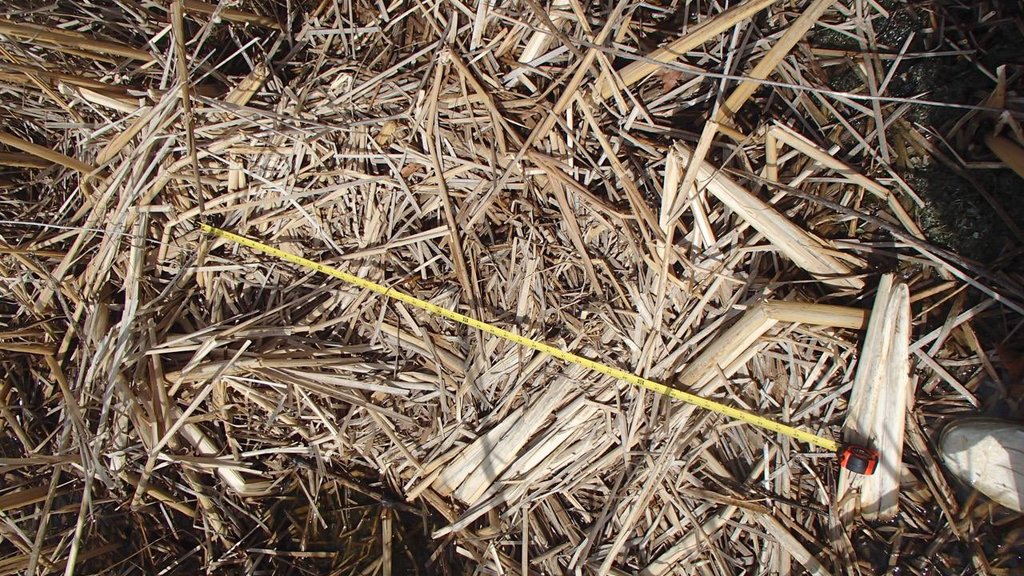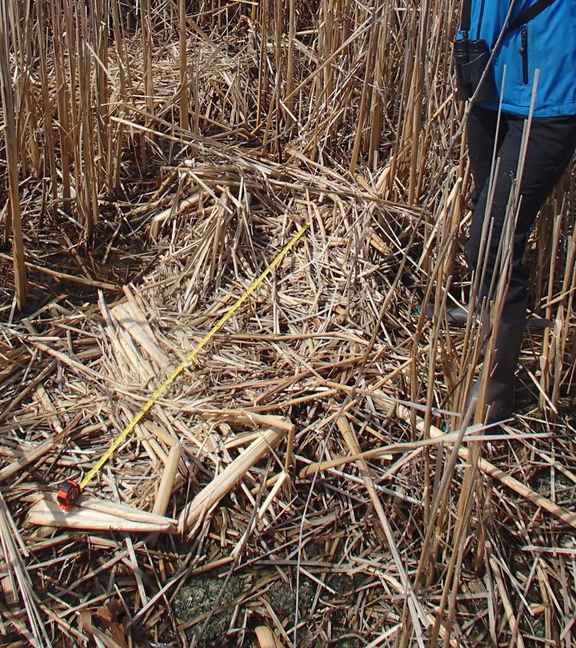

Wildlife biologist Mike Bottini says that, since 2008, the river otter’s range has doubled in size on Long Island. “I expect to see them on the South Shore [of Fishers Island] within the next couple of years,” he said.
From Mar. 21-23, 2013, Bottini surveyed 57 sites on Fishers Island by foot and kayak. Otter sign was noted at 24 sites, with scent stations (scat) found at 23 sites and otter tracks at one site. Two scent stations also had a den nearby. His survey was funded by a grant from FIConservancy.
These photos from Southold show typical river otter couches excavated amongst cattail reeds, usually in marshy areas. Please remark if you happen upon one this Autumn here on Fishers Island!
From the Field, Field Note by Justine Kibbe, Aug. 29, 2018.
Monarchs Munching
From the Field, Video Snippets“What’s for Munch?”
Monarch caterpillars feeding within planted Milkweed here on Fishers Island.
Bring. Butterflies. Back.
From the Field, Video Snippet by Justine Kibbe, Sept. 8, 2018
The Sound of Serenity
From the Field, Video SnippetsToday, serenity was the view from Hay Harbor club golf course, Fishers Island. Race Point and South beach are surrounded by lush Eelgrass, providing critical habitat for fish species within Long Island Sound.
But fewer than 400 acres of this precious seagrass meadow remain, most of it within Fishers Island waters…
From the Field, Video Snippet by Justine Kibbe, Sept. 5, 2018
“All the News That’s Fit to Print”
Field Notes, From the FieldHeading out into The Field, Fishers Island.
Always a “story” to follow:
Deer. Raccoon. Coyote. Pheasant.
From the Field, Field Note by Justine Kibbe, Aug. 30, 2018
Along Came a Spider
From the Field, Video SnippetsAfter morning’s “Spin Class”…
This spider is a common orb-weaver that often appears in September. They spin large elaborate wheel- (or orb-) shaped webs daily to capture their prey and often break down the web and recreate the same design after a successful catch. The spiders eat a significant portion of the web to regain the nutrients needed to spin a new web for the next day.
From the Field, Video Snippet by Justine Kibbe, Aug. 31, 2018
Thistle Do It!
From the Field, Video SnippetsTall thistle, a native wildflower, is a big favorite among pollinators.
Here, within historic Parade Grounds, Fishers Island, bees and butterflies busily tend to their habitat. Want to help attract Monarch butterflies? Thistle do it!
From the Field, Video Snippet by Justine Kibbe, Sept. 2, 2018
River Otter: Call it a “Day-bed”
Education, Field Notes, From the FieldWildlife biologist Mike Bottini says that, since 2008, the river otter’s range has doubled in size on Long Island. “I expect to see them on the South Shore [of Fishers Island] within the next couple of years,” he said.
From Mar. 21-23, 2013, Bottini surveyed 57 sites on Fishers Island by foot and kayak. Otter sign was noted at 24 sites, with scent stations (scat) found at 23 sites and otter tracks at one site. Two scent stations also had a den nearby. His survey was funded by a grant from FIConservancy.
These photos from Southold show typical river otter couches excavated amongst cattail reeds, usually in marshy areas. Please remark if you happen upon one this Autumn here on Fishers Island!
From the Field, Field Note by Justine Kibbe, Aug. 29, 2018.
Red-tailed Hawk vs. Mink
NewsThis dramatic image of a red-tailed hawk with its prey, a mink, is proof of the existence of minks on Fishers Island. The mink population here is described as “vibrant”.
Placid Plover
From the Field, Video SnippetsThis semipalmated plover forages for marine worms within low tide’s mudflats, Fishers Island.
Named for the partial webbing found between its toes, this shorebird species “appears” to be increasing in numbers both on South beach and Big Club beach.
From the Field, Video Snippet by Justine Kibbe, August 24, 2018
Ospreys in Southold Town
NewsBill Colman captured this image of an osprey hunting for fish July 20, 2018 at a dock owned by his in-laws, Bob and Margot Meyer. The picture was taken with a Nikon D800 camera.
Southold Town, which includes Fishers Island, Plum Island and Robins Island, has the densest population of breeding ospreys in eastern Long Island. In 2018, Andrew Edwards used a drone to record 34 fledglings in 17 active nests on Fishers Island.
Dolphins Make Appearance
News, SentinelsMax Soper shot this video of a few pods of dolphins Aug. 4, 2018 in Fishers Island Sound, with Hay Harbor in the background, and shared his exciting observation with FIConservancy. Island Sentinel Gardner Thors was also aboard to confirm sighting.
Although locally reported sightings are relatively rare, common dolphins have been seen in Long Island Sound with increasing regularity since 2009. Observers say they are venturing farther north for big schools of prey fish: Silver-and-yellow Atlantic menhaden (often called “bunker”) form schools by the thousands and are a favorite target for dolphin, porpoise and humpback whales.
Dolphins typically swim 2-4 mph but can reach speeds of 20 mph for brief periods. Coastal dolphins typically do not hold their breath for more than five minutes, which makes for good viewing.